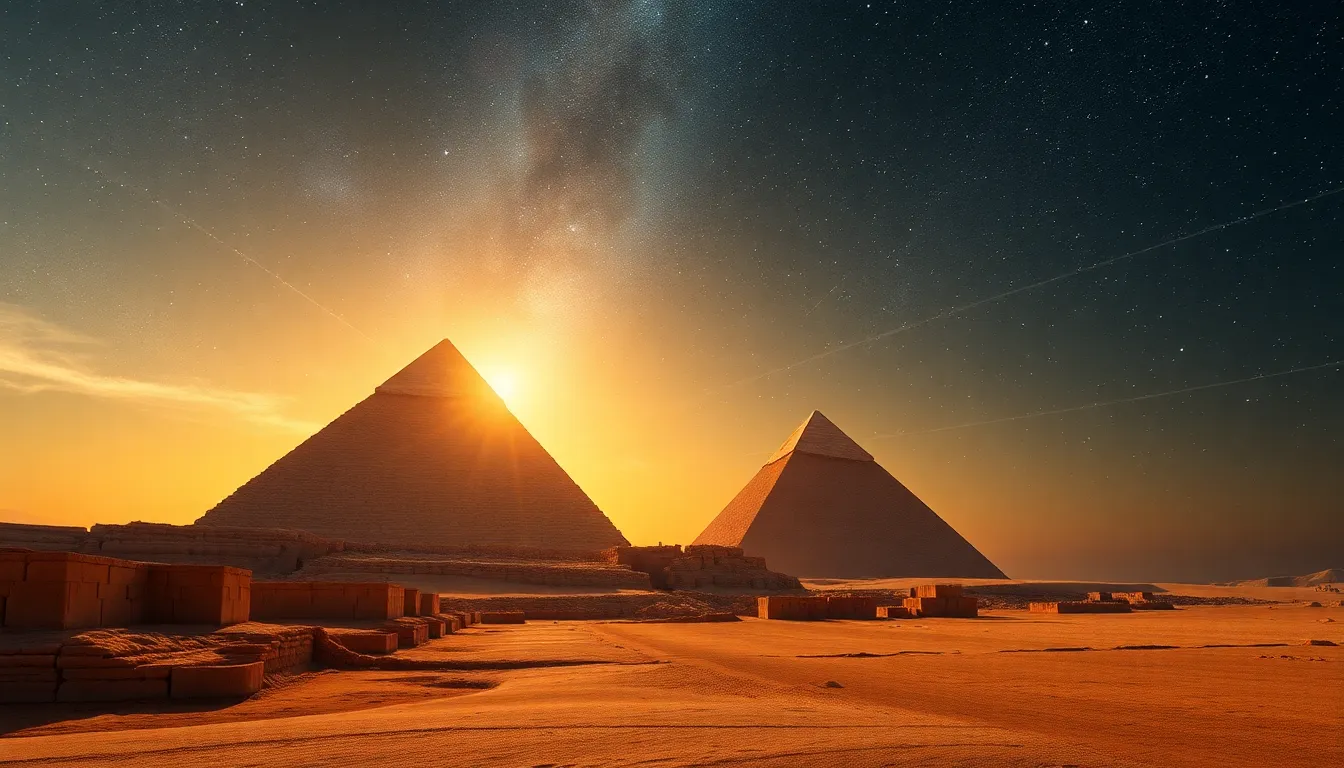The Great Pyramid and the Stars: Alignments with the Cosmos
I. Introduction
The Great Pyramid of Giza, one of the most iconic structures in the world, stands as a testament to the ingenuity and ambition of ancient Egyptian civilization. Built during the Fourth Dynasty around 2580–2560 BC, it served as a monumental tomb for Pharaoh Khufu. Its sheer scale and precision not only showcase the architectural prowess of the Egyptians but also hint at a deep understanding of astronomy that permeated their culture.
Astronomical alignments in ancient architecture have long fascinated historians and archaeologists. The Great Pyramid, in particular, is known for its precise orientation and its relationship with celestial bodies. This article explores the intricate connections between the Great Pyramid and the cosmos, revealing how the ancients viewed their place in the universe.
II. Historical Context of the Great Pyramid
The construction of the Great Pyramid is believed to have taken about 20 years, employing thousands of workers, including skilled laborers and craftsmen. It was designed as a grand tomb, reflecting the Pharaoh’s power and ensuring his safe passage to the afterlife.
The role of the Pharaoh in ancient Egyptian society was pivotal. Considered a living god, the Pharaoh was not only a political leader but also a religious figure responsible for maintaining ma’at, or cosmic order. This connection to the divine underpinned the massive efforts to construct monumental architecture like the pyramids, which were aligned with the stars as part of their religious significance.
Egyptian cosmology played a crucial role in the design of the pyramids. The ancients believed that the cosmos was a reflection of the divine order and that their earthly actions could influence the heavens. This belief was integral to the pyramid construction process, as the structures were designed to facilitate the Pharaoh’s journey into the afterlife among the stars.
III. The Astronomical Alignments of the Great Pyramid
The Great Pyramid is renowned for its precise alignments with cardinal points. Its sides are closely aligned with the four cardinal directions: north, south, east, and west. This alignment was not merely for aesthetic purposes; it had significant astronomical implications.
Additionally, the Great Pyramid is oriented towards specific stars that held importance in ancient Egyptian mythology:
- Sirius: Associated with the goddess Isis, Sirius’s heliacal rising marked the beginning of the Nile’s flooding, a crucial event for agriculture.
- Orion: The constellation Orion was linked to Osiris, the god of the afterlife. The alignment of the pyramid’s shafts is thought to connect the Pharaoh with this celestial figure.
The concept of the “Celestial Nile” further emphasizes the pyramid’s connection to the cosmos. The Nile River was seen as a terrestrial mirror of the Milky Way, and the pyramids were positioned to reflect this sacred geography.
IV. The Role of Stars in Ancient Egyptian Religion
Stars held immense significance in ancient Egyptian religion, particularly concerning beliefs about the afterlife. The Egyptians believed that the souls of the deceased would ascend to the stars, where they would live in an eternal paradise alongside the gods.
Several major deities were associated with celestial bodies:
- Osiris: Often linked with the constellation Orion, Osiris was the god of resurrection and the afterlife.
- Isis: As the sister and wife of Osiris, she was associated with Sirius, representing fertility and rebirth.
Festivals and rituals were intricately tied to stellar events, such as the annual flooding of the Nile, which was closely linked to the rising of Sirius. These events were celebrated with elaborate ceremonies that reinforced the connection between the earthly and celestial realms.
V. Theories Behind the Pyramid’s Cosmic Alignments
The ancient Egyptians possessed a remarkable understanding of astronomy, evidenced by their ability to construct such precisely aligned structures. Theories suggest that these alignments served various purposes:
- Navigation: Alignments may have guided travelers and navigators by providing celestial landmarks.
- Religious Significance: The alignments were likely intended to ensure the Pharaoh’s safe passage to the afterlife, connecting him with the gods.
Recent archaeological findings have supported these theories, revealing more about the astronomical knowledge of the ancient Egyptians. Artifacts and texts suggest they meticulously observed celestial movements, using this knowledge in their architectural endeavors.
VI. Modern Interpretations and Research
Modern researchers employ various tools and technologies to study the astronomical aspects of the Great Pyramid. Techniques such as satellite imagery, 3D modeling, and astronomical software have provided new insights into the pyramid’s alignments and their significance.
Contemporary researchers and astronomers have made significant contributions to understanding the Great Pyramid’s cosmic connections. Their work compares the pyramid’s alignments with other ancient structures worldwide, revealing a broader pattern of astronomical knowledge across different civilizations.
VII. Cultural Impact and Legacy
The Great Pyramid’s influence extends beyond ancient Egypt, impacting modern architecture and astronomy. Its design principles and astronomical alignments have inspired countless architects and engineers throughout history.
In popular culture, the Great Pyramid has become a symbol of mystery and intrigue, featured in films, literature, and documentaries. Its construction continues to captivate the imagination, sparking numerous theories and explorations into its purpose and origins.
The ongoing fascination with the Great Pyramid underscores the enduring legacy of ancient civilizations and their profound connections to the cosmos.
VIII. Conclusion
The Great Pyramid of Giza stands as a remarkable achievement in both architecture and astronomy, reflecting the ancient Egyptians’ deep understanding of the cosmos. Its alignments with the stars reveal a rich tapestry of beliefs and practices that intertwined religion, culture, and science.
As we reflect on the intersection of history, science, and mythology, the Great Pyramid invites us to continue exploring the mysteries of ancient civilizations and their connections to the universe. The journey of understanding these cosmic ties is far from over, beckoning future generations to uncover the secrets that lie within.




